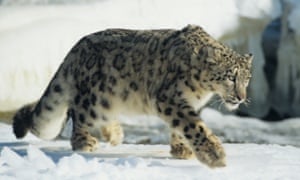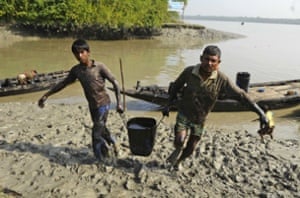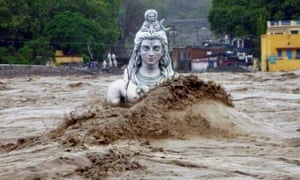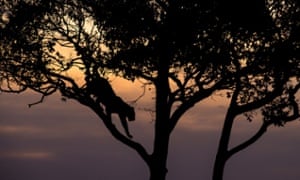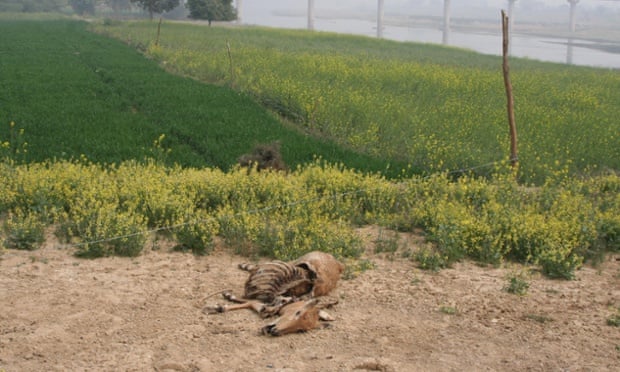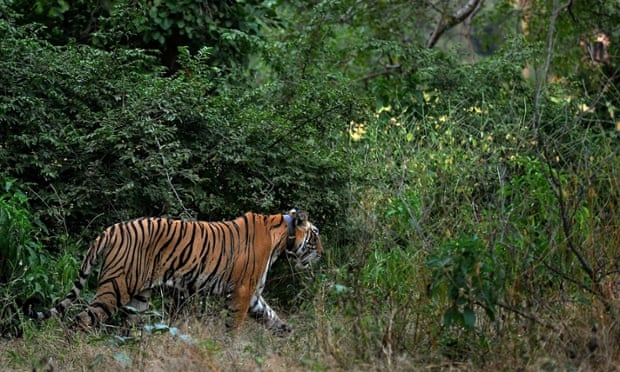Manaram keeping an eye on his camels
Camels sit with their long limbs tucked under them or repose languidly on their sides, chewing their cud. A couple of calves, covered in soft curly wool, stand next to their mothers. They watch tractors drive by the dusty lane and women herd water buffaloes and goats. Children with hastily washed faces carry satchels to school.
I know I have arrived at my destination in Mundara, Pali district, Rajasthan.
I wait for Hajiram, the man I had come to see, in the courtyard, under the dappled shade of a banyan tree.
A young man emerges from the house, introducing himself as Baburam, Hajiram’s son. A camel rises quickly and awkwardly to its feet—one leg is hobbled. Baburam approaches it, slings a noose around its neck, and brings it to its knees. It brays loudly like a donkey, and raising its hairy tail, ejects copious amounts of jamun-shaped green droppings. The man grabs the animal’s snout and it screams as if it is being slaughtered. Its unsympathetic flock mates continue to chew the cud.
Baburam’s elderly father, Hajiram Dewasi, makes an appearance now. He splashes the camel’s ear with warm water, and squeezes and extracts white gobs of pus. After he applies a salve, his son releases the camel. It scrambles up on three legs and suspiciously watches the men examining the others.
The men tend to one with an infected foot and rub another with medicated oil. Ministrations done, Baburam begins milking a camel. It is perhaps the only dairy animal a man can milk standing upright. Surprisingly, he doesn’t bother to tie her legs or restrain her in any way. She stands placidly while her calf suckles on one side and the man milks her from the other. Tending to wounds and milking are a daily morning routine in every camel-herding household, unchanged for centuries.
Baburam pours some milk into a small steel bowl and offers it to me. It is warm, as if heated on fire. I savour it, trying to elicit every nuance of flavour, not distracted by the thick head of foam stuck to my upper lip. I can only detect a vague saltiness, and it tastes no different from cow’s milk. Later, I hear others describe camel milk as relaxing and addicting. Baburam takes the vessel into the house to make tea.
On any other day, this would be the cue for Hajiram to leave with his herd. But he has agreed to a delay of a few minutes to talk to me. Although in his sixties, he doesn’t seem the kind to sit still. He picks up two balls of camel wool yarn and settles down beside me on a charpoy. Throughout our conversation, he twirls a spindle, twisting two strands of wool into a sturdier yarn that will later be turned into a dhurrie.
Hajiram is dressed in the costume of his forefathers—white long-sleeved angarke, white dhoti, and gold ear hoops glinting in the light. An enormous, intricately wrapped maroon turban adds a touch of colour. Baburam looks like any other young man of this generation, dressed in a polo shirt and trousers. A gold wire looped through each earlobe is the only visible evidence of his Raika heritage.
Livestock herders Baburam and Hajiram belong to the Raika caste which specialises in rearing camels. I ask Hajiram how his community became so closely associated with these animals of the desert. Continuing to twirl the yarn, he tells me a story.
When Shiva was lost in meditation, his wife, Parvati, grew bored. She fashioned an animal with five legs out of sediment from a pond. When Shiva finished his meditation, she asked him to give the figurine life. The animal couldn’t walk forward or backward. So he folded one leg over its back and that’s how the camel got its hump.
The animal started running, and Parvati grew tired chasing after it. She said she needed a man to do the job. So Shiva rolled dirt off his body and fashioned the world’s first Raika.
But did Shiva set the Raika down in Baluchistan? Historians think the community probably moved eastwards to India with Muslim warriors in the 10th century. Rajput rulers, notably the maharajas of Bikaner, Jodhpur, Udaipur and Alwar, employed some to manage their camel breeding operations and camel cavalry. Other Raika had their own breeding herds.
Traditionally, the Raika didn’t trade female camels; it was taboo. The only time they changed hands was during weddings, when they accompanied brides to their new homes. Nor did the vegetarian pastoralists sell camels for meat. Although camel milk tasted just fine, the herders didn’t sell that either. Trade in male calves as draft animals underpinned the entire economy of camel herding.
***
Raika herders walk for days with their camels to reach Pushkar
Hajiram’s family owned about 100 camels three decades ago, but now it has only 50. Besides the 10 snorting and braying impatiently outside in the courtyard, the rest live in Latara with another camel breeder.
Hajiram grazes his camels on the outskirts of Mundara village for up to 12 hours a day for most of the year. They browse on trees in village pastures and on crop stalks left over from the harvest in fallow fields. In exchange, their nutrient-rich droppings fertilise the soil. Once the rains begin in June, farmers plant crops and camels are not welcome. Pastoralists with their sheep, goats, cows, and camels migrate to Kumbhalgarh Wildlife Sanctuary in the Aravalli hill range. But for the past four decades, livestock is prohibited from the reserve and trespassers are fined. The loss of critical summer grazing grounds hits the Raika hard.
Baburam says, “Camels don’t eat grass. They eat leaves, even neem leaves. That’s why camel milk is like medicine. Camels don’t compete with any other animal as nothing else eats leaves. We tried very hard to make the forest people understand, but they don’t listen to us. We’ve become criminals. Our samaj went to Jaipur and to Delhi (to meet politicians), but that didn’t make any difference.”
For centuries, the Raika traditionally relied on the forest four months of the year, and they continue to use it on the sly. Baburam says, “In our village alone, there are 150 camels. Where else can we go? Other villages also have the same difficulties.”
The camel has been an iconic symbol of Rajasthan for decades, but it was declared the state animal only on June 30 this year. I ask, “Has that elevated status not made a difference?”
“Our camels are even worse than before,” Baburam replies. “The government won’t subsidise their upkeep, we have no grazing grounds, and we don’t get good prices for camels. Why would anyone keep them? I’ll keep a few because it’s a tradition. I can’t say if my children will.” We turn to look at his five-year-old son, who stands at the doorway, chewing his forefinger. He ducks inside shyly.
The chorus of bellows and grunts outside the house grows louder. Hajiram urges one of his teenage grandsons to take the animals foraging. Hajiram’s wife has packed a stack of rotis at the end of a long piece of cloth. This is the boy’s sustenance for the day. He slings the cloth over his shoulder, picks up his grandfather’s long stick and a steel pot in which to milk camels, and leaves the house.
I ask the men, “Are you able to make a living with your camels?”
Baburam says, “I don’t sell camel milk because I don’t get a good price. If I started to sell milk, I’ll compromise the health of our calves. I prefer to get a good price for healthy calves than make little by selling milk. I have eight buffaloes and I also have a job in Surat. My brother runs a school here. So we are not dependent on camels. Few Raika can afford to depend only on camels.”
His father adds, “During the famine more than 100 years ago, people had nothing to eat. Our families survived by drinking camel milk. It’s because of our camels, we are here today.”
Camels were uniquely adapted to convert local vegetation to highly nutritious food. They don’t need expensive fodder, survive on little water, and walk long distances in the heat to find edible leaves.
While buffaloes and cows struggle to survive a bad drought, the Raika depend on camels to not only carry on but also sustain their families.
Although there is no sign of disagreement between them, I wonder if there is an underlying tension between father and son. Has Hajiram been reluctant to sell the family’s camels and the purchase of buffaloes?
As I rise to leave, both men insist they will meet me at the Pushkar camel fair the following week. Baburam says he wants to see the prices camels were fetching, and also to buy accessories he can’t get elsewhere.
Outside, once we’re out of earshot of his father, Baburam whispers, “I’m keeping camels just to keep my father happy. I can’t bear to see his sadness if we sold them all. In my family, I’m the eighth generation to keep camels. But it’s a struggle to keep them fed.”
***
From Mundara, I make my way south to Sadri town and towards Ranakpur. There are numerous temples along the way. Although ubiquitous throughout Rajasthan, camels do not figure in temple art. Goddesses sit astride lions or tigers, while doorways are guarded by elephant motifs. Were camels not sanctified because they were common?
I go to meet Dailibai, a feisty spokesperson for pastoral rights, near the famous Ranakpur Jain temple. She sits in the middle of the room wearing a long skirt and a bright pink odni pulled over her head. One arm is encircled entirely by white plastic bangles that in her mother’s time would have been of ivory. The other is wrapped in a bandage, healing from a fracture. A large gold nose ring partially hides her smile, while silver earrings so heavy they distend her lobes swing and tinkle as she talks.
She says, “Camels need forests to graze. Trees and plants benefit from animal dung and urine. Seeds dispersed by animals grow faster. Even if there were more nilgai to do this job, you cannot g
et milk, ghee, or anything from them. Camels eat the leaves of many different species of trees and that’s why people who drink their milk are healthy.”
I make the case for forest protection. “Kumbhalgarh is the only forest in the entire Aravalli range. It’s the only refuge for wild animals. Shouldn’t it be protected from people?”
“Even the foresters’ fathers cannot save this forest,” she shoots back. “They take money on the side and let you cut trees. Many resorts have come up inside. They will finish the jungle. Only pastoralists can take care of forests. Since the ban on livestock, there are more fires than before. With no goats or sheep to graze, the grass grows high. People who go to collect honey set fire to the dry grass. In earlier times, if there was a fire, people beat a big dhol and summoned the whole village. We would put out the fire. Now nobody goes to put out fires. The whole forest burns for two months sometimes.”
***
It’s a clear morning and I watch 55-year-old Manaram tend to a herd of 15 camels. Just like Hajiram and Baburam, he doesn’t miss a wound or scratch. One young male tries to bite him as he struggles to control it. The camel succeeds only in unravelling the long length of twisted maroon cloth that forms the turban. Manaram quickly wraps it back into place and goes back to ministering the camel. The turban is more than a mere insulator from the desert sun; it is a helmet to protect Raika heads from the unwelcome attentions of these tall animals.
Manaram does not seem to be doing well. He wears a torn polyester shirt over his dhoti, and his earlobes are devoid of ornaments. He looks gaunt, and his arms and legs are as thin as sticks.
It’s 9 a.m. when Manaram is ready to leave, and I tag along. He drives the herd with a series of barked commands towards a forested hill. The animals’ soft padded feet are sensitive to sharp stones and thorns. Bells around the necks of a couple of adults tinkle as they move through a forest of thorny Prosopis. Even though the animals walk sedately, I have to walk briskly to keep up. Occasionally, one stomps its foot in alarm at my proximity, and I move away, afraid of being kicked.
A young calf frequently stops to look at Manaram and brays as if to ask, “Can’t we stop here?” Manaram goads it onward.
Half an hour later, we are inside Kumbhalgarh forest. When the animals want to stop at the first edible tree, Manaram refuses to let them. “Move on,” he seems to say by clicking his tongue. Finally, he deems we are in a good forest and lets the camels forage. With a loud sigh, he sits down in the shade on a boulder, while the animals fan out into the grove.
I watch their extremely mobile lips pick leaves from thorny branches. They strip leaves with a swift movement from thornless ones. The yellow flowers of the white bark acacia trees and curly, green pods of sickle bush trees are favourites. Although Manaram seems half-asleep, he keeps an eye on the herd. When a camel ventures off down the path, he called, “Karje, Karje.” The animal comes back.
“Is that the name of the camel?” I ask.
He nods.
If I ask Manaram a question in Hindi, he answers in a rapid Marwari that I can’t comprehend. Our conversation is reduced to simple questions and answers accompanied by gesticulations.
Mostly, we walk in companionable silence behind the camels. Often, I catch one looking down at me as we walk along the path. Once Manaram gives the command to forage, they lose interest in me and approach fruiting trees with eagerly outstretched necks.
At noon, we come up on a flowing creek. Even though the day is hot and I have gulped down almost all the water I carried, the animals hardly seem to need water. They take a short drink and seem more interested in the lush vegetation along the banks. The only people we meet along the way are herders with cattle and goats. Manaram exchanges a few words with them and we carry on.
Langurs shake tree branches in a display of dominance and doves shoot like bullets through the sky. The wind whistles through the trees and the camels’ bells tinkle softly. When we sit down for a rest, we watch magpie-robins bob on the path, picking up insects. As the sun descends from the noon sky, the harsh light slowly turns gentle and mellow. I ration the last few mouthfuls of water and eat biscuits for lunch, but I feel refreshed by the contemplative time I spent with the camels.
At 6 p.m., as dusk begins to colour the sky, Manaram gives the command to return. Obediently, the herd sets off and we tail behind. Although I have spent the day with them, the camels continue to look at me with suspicion. It is dark by the time we return to Rajpura village.
***
The next morning, I chat with Gemunaram, a 40-year-old Raika herder with a beaked nose, heavy-lidded eyes, and an easy laugh. He lives about 15 kilometres from Rajpura, and he also takes his camels into Kumbhalgarh forest.
“What are the dangers in the forest?” I ask
“Leopards,” he replies.
“Do they take calves?”
“No. Adult camels.”
He says leopards roll on their backs, waving their legs and twitching their tails. When camels approach to take a closer look, as they are wont to do, the cats grab their necks.
“Do you chase the leopard away and save your camel?”
“No. I let it go, or it might jump on me instead. Then the leopard has enough to eat for a year. If we didn’t take livestock into the forest for grazing, leopards will die of starvation. Or they’ll come to villages. If it eats one animal, it makes no difference. I have 10 others.”
After a pause, Gemunaram says that more than leopards, sloth bears are the real danger. While the cats only take camels, startled bears or mothers protecting their young lash out at herders with their long, sharp claws. People have suffered grievous injuries and sometimes even lost their lives.
“It’s a good thing they don’t let you go in to the forest that has so many dangerous animals,” I tease.
“Taking camels foraging is a lot of fun. I drink camel milk. They have fun and I have fun,” said Gemunaram, laughter creasing his face.
Our conversation is short as he has to take his camels out, but he promises to meet me at Pushkar. Then he’d have time to chat at length, he says.
Hanwant Singh Rathore, the portly director of the NGO Lokhit Pashu-Palak Sansthan (LPPS), gives some context to the pastoralists’ use of forest. Much before Independence, Kumbhalgarh was a royal hunting ground and grazing was allowed in some parts of it. After Independence, pastoralists paid a fee to the forest department, the new custodian of the forest, and continued to graze their livestock. In the 1970s, the forest was protected as Kumbhalgarh Wildlife Sanctuary and declared off-limits to pastoralists. When guards found livestock grazing within the forest, they seized them and levied heavy penalties, up to Rs. 500 per camel.
Many conservationists and foresters are concerned about degradation of forests and over-grazing. In an assessment of the threats facing wildlife in Kumbhalgarh, biologists Anil Chhangani and S. M. Mohnot, and geographer Paul Robbins say the number of wild animals in the park has declined.
Although tigers became extinct here in 1960, the populations of other carnivores such as leopards, hyenas, and jackals have grown or remained stable. Nilgai and wild boar numbers are surging because they survive on crops, but the populations of chinkara, four-horned antelope, and sambhar are plummeting. Scientists speculate the drought of 2000 severely affected these wild herbivores, and their ability to cope may be compromised by competition with livestock.
Although the ban on livestock is the official policy, the Raika and other pastoralists march into the forest with several thousands of livestock during the rains. There are no records of how many livestock enter the forest every year, or how much the department collects as fines. Every Raika I interviewed said they don’t receive a receipt for the fine, and they accuse forest officials of exploiting the ban to enrich themselves. When the amount of money they had to pay as fines broke the bank, pastoralists took drastic measures. In 2010 and 2012, thousands of Raika gathered in Sadri to protest the ban. Dailibai gave a fiery speech and emotions ran high.
Since then the department hasn’t imposed fines on trespassing herders. This free-for-all with none of the fire prevention and control responsibilities is hardly the solution. But the status quo continues.
***
It’s not just the Raika of Pali District who face restrictions on livestock foraging. In Bikaner, the Indira Gandhi canal destroyed the best camel areas. With water for irrigation readily available, farmers from the Punjab settled there to grow three crops a year. To prevent free-ranging camels from crop-raiding, they often resort to cruel measures such as tying up the mouths of camels or tying thorny branches to their tails so the animals can’t rest. The army took over a vast tract of land between Jaisalmer and Pokharan, and trespassing camels were shot dead. Wind and solar farms occupied other pasture lands.
Unable to feed their animals, the Raika sold female camels, despite the traditional prohibition. They also violated another taboo: camels were sold for meat in Uttar Pradesh, and many were smuggled across the border to far away Bangladesh. Since 2002, community leaders, aided by LPPS, have appealed to the Raika to not sell female camels, or at least sell them to other Raika even if they paid less. They wrote letters to the district magistrate, collector, and animal husbandry departments to stop the slaughter of camels. Their appeals appeared to fall on deaf ears for more than a decade, as India dropped from owning the third largest camel population in the world in 1990 to the seventh position in 2007. In 1997, Rajasthan had nearly 7,00,000 camels, while in 2012, it had only 4,00,000.
According to LPPS, that number fell even more drastically to 2,00,000 in 2014.
At one time, a herd of 25 to 30 camels was enough for a family to sustain itself. Ones with hundreds of camels were considered rich. Then, women were said to have appealed to their parents, “Mere ko jin gao panaye jisme sandia hain,” meaning ‘Marry me into a village with many she-camels.’ But in recent decades, as the value of camels fell so did the stock of herders. Young men who lived the traditional life can’t get brides.
In 2014, a draft bill—banning the slaughter of camels, transport of the animals out of the state, and castration of males—was tabled in the Rajasthan state assembly. Far from welcoming the move, Hajiram, Baburam, Dailibhai, and Gemunaram are of the unanimous opinion the ban on killing ought to apply only to female camels. Male camels should be exempt from the ban, they say.
The bottom has fallen out of the market for male camels. Farmers moved to tractors and traders preferred trucks to slow-plodding camels. Even the camel-borne Border Security Force that patrolled the sandy border areas with Pakistan declared it would switch over to all-terrain vehicles. The animals are more sought after outside the state than within, but the draft bill would prevent their export. If there was no one to buy male calves in Rajasthan, how would the Raika survive? They couldn’t keep them either.
In winter, male camels go into rut, a testosterone-charged condition called keenja. Gemunaram says, “Adult male camels become obsessed with females and will kill any other males in the herd, even young ones. During that time, we don’t take the males out foraging. The only way to manage them is to tie their legs and stall-feed them.”
It’s not just other male camels that need to watch out. Gemunaram says, “One bit my father’s arm and its teeth penetrated right through. In Malwa, a boy hit a camel in keenja with a stick. The next year, during rutting season, when the boy was asleep, the camel sat on him and squashed him to death. I hit a male camel once to make it obey. The next year, when it went into keenja, it followed me everywhere. It was trying to kill me. I sold him away. One of my three sons is deathly scared of camels since that incident.”
Male camels may have a nasty reputation in winter, but they are gentle, uncomplaining souls the rest of the time.
Ilse Kohler-Rollefson, a German activist for pastoral rights, spends part of the year in Sadri. A tall blonde with blue eyes, she loved to wear clothes with camel motifs. I ask her, “Why are camels absent from temples?”
She replies, “Elephants signify good luck, lions for victory, and camels symbolise love.”
In a famous Rajasthani love ballad, the hero Mahendra’s camel Chikal transported him 200 km. every night from Umerkot to meet his lover, Momul, at Lodurva, near Jaisalmer. Before dawn broke, the camel valiantly took him back home only to bring him back that night.
As long as a male camel has a harem of females to himself, there is no problem. The slightest provocation in the form of male calves brings out the worst in them. Perhaps this is why the Pushkar camel fair takes place in late October, just ahead of the winter troubles. Camel breeders can sell their male calves and maintain peace in their herds.
***
Arriving at Pushkar
Five days before the official inauguration of the fair on
October 30, camels begin congregating on the western edge of town. Some herds walk
for 14 days to get there. After a couple of days, Ilse and Hanwant, regular
attendees of the annual mela, pronounce there are far fewer camels than any
preceding year. Pointing to the vast sloping open field covered with parthenium
weed, otherwise known as congress grass, they say it used to be covered in
camels. Now, bunches of the weed’s untrampled flowers point heavenward, as
herds of camels stand in tight knots. The draft bill banning the slaughter of
camels has put a damper on the proceedings. None of the Raika I had planned to
meet arrive.
Calves recently separated from their mothers bray and bleat
in loneliness. Some try to suckle from unrelated females, while others set off
on three legs, with the hobbled fourth tied up, to look for their mothers.
Herders use a repertoire of whistles and commands to keep their camels from
mingling with others. When desperate youngsters pay no heed, the men have to
round them up.
Large adult males pull bedecked tourist-filled carts along
the one road skirting the grounds. Rutting season hasn’t set in yet, and the
males stride sedately, chewing the cud, seemingly unaffected by the bustling
photographers, gawkers, musicians, trinket sellers, and children dressed up in
traditional finery.
In the middle of the day, from the shade of a Gujjar’s tea
stall, I notice a couple of men, dressed in shirts and trousers, haggling with
a group of Raika. When the herders shake their heads, refusing their offer, one
of the men waves a sheaf of Rs. 500 notes, as if to tempt them. When the
turbaned men flatly refuse, turning away from the cash, the prospective buyer
puts the money away inside his shirt and wanders over to the next herd. This
herder seems amenable to selling and cash exchanges hands.
That’s when I notice the buyer’s assistant carrying an old Coke
bottle sloshing with black liquid. Dipping a twig into the container, the man paints
a large F in black on the necks and
shoulders of adult female camels. These marked animals, some accompanied by
calves, are destined for slaughter.
Deal done, the buyers come to the stall for tea. They say they
paid Rs. 36,000 for two adults that they’d rent out in Delhi for wedding
processions. But they marked more than two adults. The draft bill has made
everyone nervous, and nobody wanted to admit to anything. As we sit drinking
our tea and watching the scene, cheerful tourists take photographs of the
doomed animals.
During the day, the Raika visit their friends and drink camel
milk tea out of steel bowls. They grumble that the price of camel milk was low.
They can’t get more than Rs. 20 for a litre. “Even a bottle of water costs that
much,” one says. They all want Saras, the state dairy cooperative, to set up a separate
unit for camel milk. If they get good prices, they won’t sell their females,
they say.
“All the best milk yielding breeds are being sold for meat,”
Ilse despairs. One of the herders picks up a fistful of dirt and polishes a
used bowl. He pours tea into it and offers it to me. I balk for a moment before
accepting it.
By the third day, many Raika complain that the price of
camels has hit rock bottom. Females that sold for Rs. 20,000 last year now
fetch between Rs. 5,000 and Rs. 7,000. Buyers for the meat market bought 15 to
20 camels in one lot. Some Raika divested from camel breeding altogether.
Every afternoon, I walk around the grounds, hoping to catch
sight of colourful ribbons tied to camel tails, the mark of a traditional
purchase by breeders who want females to augment their herds or farmers who
needed draft animals. During the initial few days, I see less than five such
animals.
When it is clear no more camels are arriving at the fair, I
drop in at the office of the fair administrator at the animal husbandry
department. Only 4,356 camels have arrived at a fair that had seen 50,000 in
recent years. Hanwant challenges this figure and thinks there were no more than
2,500 camels.
Undisputed is the fact that a large majority of them are unsold. One
buyer says he hadn’t bought any camels because authorities said he couldn’t
take more than two camels out of the state. He says a buyer had been arrested
at the border for taking 15 camels.
Concern simmers and bubbles among the Raika. Many say this is
the end of camel rearing.
***
On the penultimate day of the fair, Baburam and Hajiram
arrive. As a venerated elder, Hajiram is immediately sucked into discussions
with other Raika. Raghunathdas, the priest of the Shree Akhil Bharatiya Ram
Raika Mandir Dharmarth Trust, calls a meeting to discuss the repercussions of
the draft bill.
Surrounded by camels and sitting on burlap sacks, the crowd
of Raika men agrees there should not be any restriction on the slaughter of
male camels. They draft a petition to Chief Minister Vasundhara Raje that includes
a demand for setting up a camel milk market, and lifting the ban on grazing in
forests. Some sign their names in a shaky hand, and most impress their
ink-stained thumbs on the petition. By the time the meeting draws to a close,
the sun has set and streetlights provide large pools of light.
The next morning, I wander around the grounds with Baburam. The
first group of Raika we meet hails him and we join the men for a sip of tea. My
stomach hasn’t revolted after drinking tea from a dirt-cleaned bowl so I accept
the beverage. One of the Raika is talking to a few men as they circle a group
of hobbled calves. The main man is dressed in a dazzling white kurta and
pyjamas. Under the cover of good-natured banter, a deal is struck.
The man in white peels a bunch of notes out of a fistful of
Rs 500 notes and hands it to the Raika.
One of his assistants ties an orange
ribbon to the calf’s tail, and the sight cheers me up.
I ask Baburam, “What do you look for when you buy a camel?”
“It should have upright ears, like a horse. Its nose should
be held high, and it should neither be too dark nor too light in colour. There
should be a gap in its armpit so its legs don’t rub against its chest.”
Baburam has other news. A couple of days before, Otaram
Dewasi, a Raika, was inducted into the state cabinet as a minister of state for
care of cows and temples. Baburam has just been hired as a cook at the
minister’s home. He has to leave for Jaipur within a couple of hours.
I ask Baburam, “Would you push for more support from the
government for the Raika?”
“Of course. But the minister knows the situation already.”
As we pick our way through the herds of camels, I notice
many adults and calves with coloured ribbons tied around their tails. But animals destined for
slaughter outnumber them. Although their owners
must be disappointed, most of the others are probably relieved to return
home unsold to rejoin their herd-mates in a familiar scramble for forage.
Baburam points out the different breeds of camels and how to
tell them apart. The Sirohi is black with whitish eyelids, the Sanchori is the
most beautiful with its nose held high, and the Malvi has a drooping lower lip.
Until he shows me, these characteristics were so subtle, I couldn’t have picked
them out myself.
That afternoon, before Baburam leaves, I ask him, “What do
you think the future holds for the Raika and camels?”
Without a pause, he replies, “If nothing changes, within a
few years, even Raika children will only see camels in picture books.”

